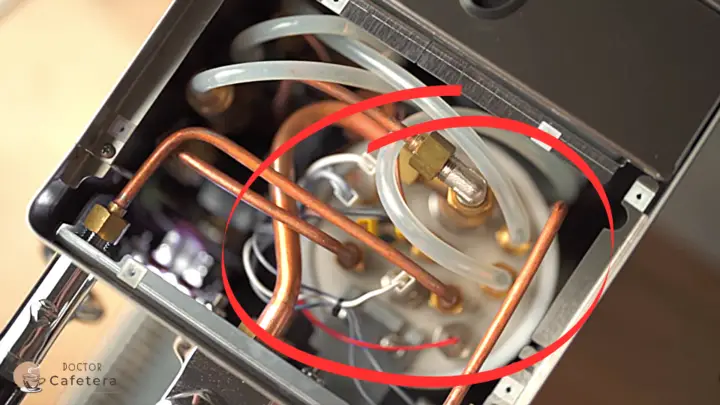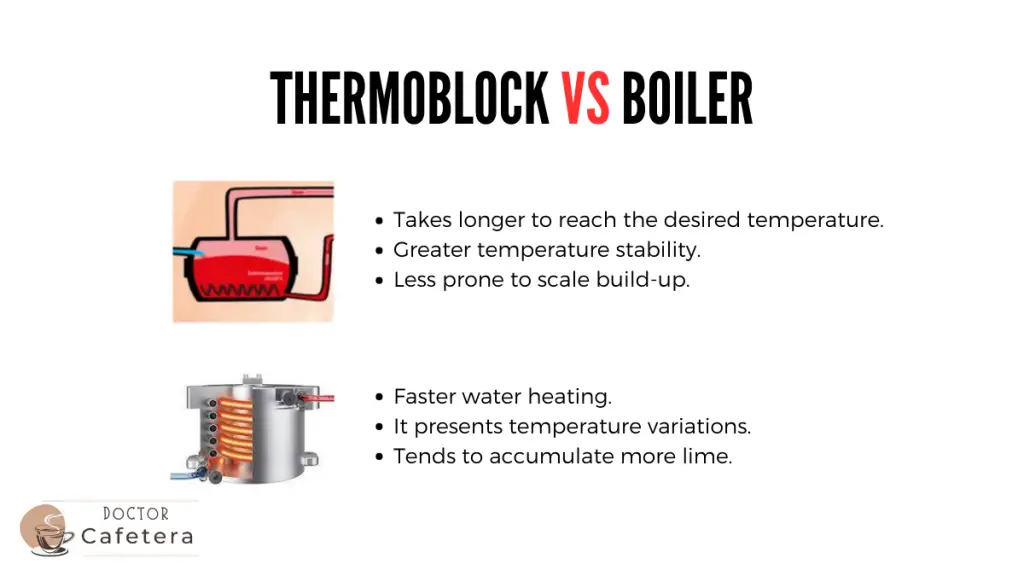Electric coffee makers use boilers or thermoblocks to heat the water, while manual coffee makers such as the Moka, French press, or Aeropress require an external heat source. In the latter, the water is previously heated in a stove or kettle and then poured into the coffee maker for use.
In the case of coffee makers with a boiler, the water is delivered from the reservoir and accumulates in a chamber with a heating element that is turned on to heat the water to the desired temperature. A thermostat regulates the temperature.
On the other hand, thermoblocks are compact heating systems with internal channels through which the water flows. Inside the thermoblock, an electric heater is activated when the coffee maker is turned on, and the water is heated rapidly as it flows through the thermoblock channels.
What is the thermoblock of a coffee maker?
The thermoblock in a coffee maker is a water heating system that uses a set of internal tubes as a coil to heat water quickly and efficiently. The coffee maker’s control board regulates both the water flow rate and the system’s pressure.
The thermoblock does not store water but draws the necessary amount directly from the tank for each preparation. When the brewer is turned on, the thermoblock heats up quickly, usually between 20 and 30 seconds, allowing the water to reach the desired temperature while circulating through the thermoblock pipes.
This design allows for rapid and controlled water heating, resulting in shorter brewing times and a constant temperature throughout the coffee extraction process. This results in better extraction of the desired flavors and aromas for a quality cup of coffee.
Most coffee pod machines, electric drip coffee makers, and those designed for fast coffee preparation use thermoblock as a heating system.
What does a coffee maker boiler consist of?
A kettle is a water heating system that uses a chamber with a heating element. Water from the tank is stored in this chamber, and the heating element is turned on to heat it to the desired temperature. A thermostat controls the temperature and prevents overheating of the water.
The boiler can heat a quantity of water greater than required for each preparation, which allows hot water to be quickly available for various uses, such as steaming milk in the case of coffee makers that use the same boiler for coffee extraction and milk texturization.
Because the boiler stores a considerable amount of water, the water leaving the brewer maintains a more stable temperature than a thermoblock. This contributes to better thermal consistency in the preparation of coffee.
Espresso and superautomatic coffee makers and those prioritizing the quality of the coffee extracted over speed use boilers as a heating system.
Differences between the boiler system and the thermoblock system
These are some of the main differences between boiler and thermoblock systems in a coffee maker:
- Water storage: In a traditional boiler, a certain amount of water is stored and kept hot for later use. In contrast, in the thermoblock system, water is not stored but is drawn directly from the tank when needed.
- Heating time: Unlike traditional boilers, which can take several minutes to reach the right temperature, the thermoblock system offers a much faster solution, as the heating time is reduced to 20 to 30 seconds.
- Temperature control: The traditional boiler system allows a more precise water temperature control, as it can be adjusted and kept constant throughout the brewing process. In the case of the thermoblock, the temperature can vary due to the rapid and direct heating of the water in the internal tubes.
- Energy efficiency: By not requiring constant storage and maintenance of hot water, the thermoblock energy savings can be achieved compared to a coffee maker with a boiler system.
- Applications: Traditional boilers are typically found in espresso, superautomatic, or high-volume coffee makers that require brewing considerable amounts of coffee. The thermoblock system is more common in capsule coffee makers.
Advantages of the thermoblock system in coffee machines
These are some of the advantages of the thermoblock system in a coffee maker:
- The thermoblock system consumes little energy and heats only the water needed for each coffee.
- Thanks to its heating speed, it allows you to prepare a cup of coffee in the shortest possible time.
- As it does not accumulate hot water inside, it prevents the water from acquiring strange odors or flavors due to overheating if it is not used for several days.
Disadvantages of the thermoblock system in coffee machines
Although the thermoblock system offers several advantages, it has some potential drawbacks in coffee makers. I will mention two of them:
- Temperature variation: Unlike traditional kettles, the water in thermoblock systems can experience small temperature variations during the brewing process. These fluctuations can affect the consistency of the coffee flavor and extraction.
- Limescale build-up: Thermoblocks can be more prone to limescale build-up due to the heating rate and direct water contact with internal components. When a thermoblock is saturated with limescale, the water flows more slowly, and the coffee extraction will not be correct.
Which coffee machines use thermoblock and why?
As I mentioned earlier, one of the advantages of the thermoblock is the speed with which it heats the water, even if its temperature control is not the best possible.
For this reason, the thermoblock system is more common in capsule coffee makers, and the boiler is more common in espresso and superautomatic coffee makers, where the emphasis is on quality rather than speed.
Boilers in espresso coffee machines
Most quality espresso machines have a dedicated boiler for the coffee and another for the steam. When the milk is heated, the water reaches a temperature close to evaporation, which makes it difficult to extract coffee immediately with that water. Therefore, in single-boiler espresso machines, it is necessary to wait for the temperature to drop or to purge water to speed up the process.
However, in early espresso machines and today’s cheaper versions, a single boiler is used for water and steam, making them more complex and delicate.
Over time, espresso machines have evolved and adopted more efficient heating and steam systems, such as heat exchangers + boiler and dual boiler systems (one for water and one for steam). These improvements have contributed to more optimal performance and higher-quality espresso preparation.
You may be interested in:


